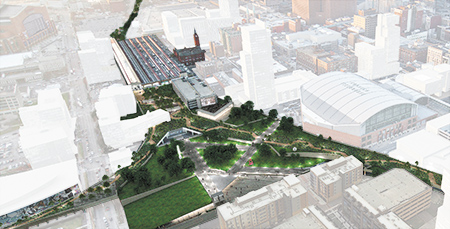Subscriber Benefit
As a subscriber you can listen to articles at work, in the car, or while you work out. Subscribe NowSince the completion of the first phase in 2009, the High Line in New York City has been one of the most talked about urban designs of the last decade. Though not the first inner-city elevated rail viaduct to be converted for public use (an honor belonging to the Promenade Plantee in Paris 20 years earlier), the High Line has inspired cities around the world to consider similar transformations. Beyond being outright beautiful, it has 4 million visitors per year, is a stimulus to adjacent development (30 new projects planned or under construction in the opening year alone), and has increased property values within two blocks to twice the neighboring ones.
Given the High Line’s resounding success, it’s no surprising there are cities that hope to duplicate it, even in small part. Making the point that no city can truly compete with the resources New York City brings to such a project, the noted urban observer and author Witold Rybczynski cautions against cities’ taking on the task motivated only by fashion or “looking for quick fixes to revive their moribund downtowns.”
 Nonetheless, the fact is, many cities like Chicago and Philadelphia are recasting rail viaducts as elevated linear parks because they face realities similar to ours. Without question, the mid-19th-century arrival of rail in Indianapolis was a turning point in our history. Later, with significant public investment, elevating the rail system along the south edge of downtown was a meaningful stimulus providing safer and restored street-level activity.
Nonetheless, the fact is, many cities like Chicago and Philadelphia are recasting rail viaducts as elevated linear parks because they face realities similar to ours. Without question, the mid-19th-century arrival of rail in Indianapolis was a turning point in our history. Later, with significant public investment, elevating the rail system along the south edge of downtown was a meaningful stimulus providing safer and restored street-level activity.
But today, a study already exists that identifies the Belt Line two miles south of downtown as the preferred and safer corridor to relocate cargo rail transport.
Downtowns are no longer primary destinations of rail freight, leaving most lines completely or partially abandoned. Even with functioning lines, the viaducts are a physical and psychological barrier, often creating the “other side of the tracks.” These elevated systems, at a century old or more, have need of repair, but the cost of removal is prohibitive.
Learning from the High Line, here are a few reasons I think Indy should take on the challenge of renovating our raised rail lines into an elevated thread of public space that I’ll call the Union Line.
First, it’s cool. All joking aside, “cool” is driving the current economy, and projects like the Union Line make a statement about the attitude of the community. More deeply, places for fun in the public realm— simple joys—are essential to our well-being. There is just something provocative about experiencing a vibrant urban setting from between the buildings and above the street.
Second, it’s an optimistic and proactive cache for the near future. It is an intentional approach to providing public space for a growing critical mass of downtown dwellers for whom high-quality green space is at a premium. As a viable transportation option, the Union Line has immediate connections to the major venues of the city (Bankers Life Fieldhouse, Union Station, Pan Am Plaza, the Indiana Convention Center, Lucas Oil Stadium and Victory Field), significant employers (including Eli Lilly and Co., Anthem Inc. and Rolls-Royce Corp.) and recreational landmarks (White River State Park, the Indianapolis Zoo and the river itself).
Third, it’s the right moment. It is the “buying Apple stock when it was a dollar” moment. The quiet success of the High Line was that it coalesced and accelerated the already growing interest in its surrounding neighborhoods. Similarly, the Union Line is fortuitously nestled within the active fine grain of the Wholesale District and significant acreage ripe for redevelopment, not the least of which is 100 acres of the former GM stamping plant west of the river.
We know from those who have gone before us that such an endeavor takes a strong public-private partnership—and a champion. We know it takes an endowment or credible monetary mechanism for long-term care and programming. We know it takes astute attention to design. Ultimately, we know it can be done. It’s time to recapitalize the investment Indy made in the Union Line nearly a century ago and position it as a catalyst for the city’s next defining moment.•
__________
Gallagher is an urban designer with Ratio.
Please enable JavaScript to view this content.

